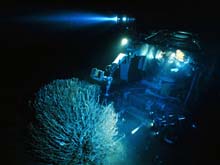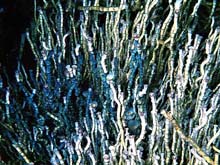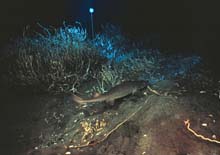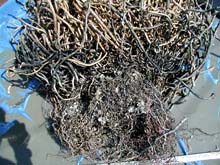
The Johnson Sea-Link working on a bush of tubeworms. The tubeworms shown here are over 5 feet long and extend far into the sediment below. Click image for a larger view.
Cold-seep Tubeworms
Stephane Hourdez
Chuck Fisher
Penn State University
Cold-seep tubeworms are big worms (sometimes as big as 10 feet long) that are found only in places in the deep sea of the Gulf of Mexico called cold seeps. These worms are closely related to other giant tubeworms found around deep-sea hydrothermal vents. These giant worms lack a mouth, gut and anus. In fact, they have no digestive system at all. But they do need food and oxygen.
They get their food from special symbiotic bacteria that live inside their body in an organ called the trophosome, which is basically a sac crammed full of bacteria. There are more than 100 billion of these symbiotic bacteria in a single teaspoon of trophosome. These bacteria are chemosynthetic, which means they can use energy from chemicals to make food. They are a bit like photosynthetic plants, but instead of using energy from light (like plants do to make food from carbon dioxide), they use energy from chemicals present in the cold seeps and hydrothermal vents. Tubeworms use hydrogen sulfide as an energy source, which is the same chemical emitted by a rotten egg.
The tubeworms transport dissolved chemicals and gasses (hydrogen sulfide, oxygen, and carbon dioxide) to their trophosome and bacteria. In exchange for a safe place to live, the bacteria use the chemicals to give the tubeworms the food they need to grow and reproduce

A group of stained tubeworms. We stain them with a blue chitin stain and then come back a year later to collect and measure them. This is how we determined that its takes more than 200 years for the tubeworms to grow about 2 meters (6 feet). Click image for larger view.
We have been studying the tubeworms at the cold seeps in the Gulf of Mexico for about 15 years and have learned that these tubeworms are, in some ways, even stranger than the tubeworms found around hydrothermal vents. The cold seep tubeworms grow fairly quickly for about ten years, but then grow very slowly for a long time. A middle-aged tubeworm will grow only about 1 centimeter per year. We discovered this by staining the tubeworms blue and then coming back a year later to see how much they had grown. After we did this to hundreds of tubeworms over the course of several years, we calculated their ages and discovered that they are the longest lived animals that we know of on Earth. They can easily live for more than 200 years!
We also have discovered that tubeworms grow down into the sediment, and then use their “roots” to take up the dissolved sulfide in the sediment that they need for their symbionts. Considering their roots, their long life, and the way they grow (making their own food), these animals have a very plant-like existence. In fact, ecologically speaking, they are similar to bushes because they provide a place in which many other animals can hide and feed. On this expedition, we will try to determine how many different kinds of animals live in the tubeworm bushes.
Sign up for the Ocean Explorer E-mail Update List.

























